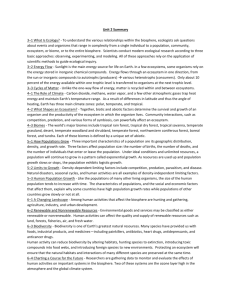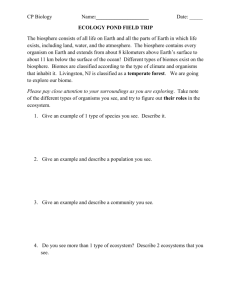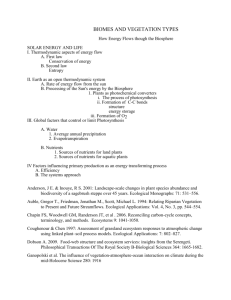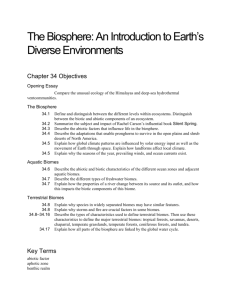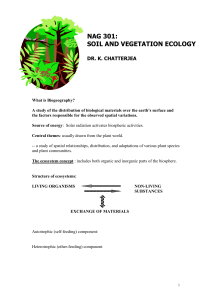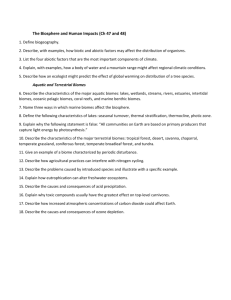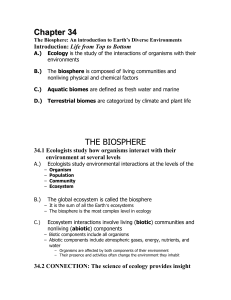the biosphere: an introduction to earth`s diverse environments
advertisement
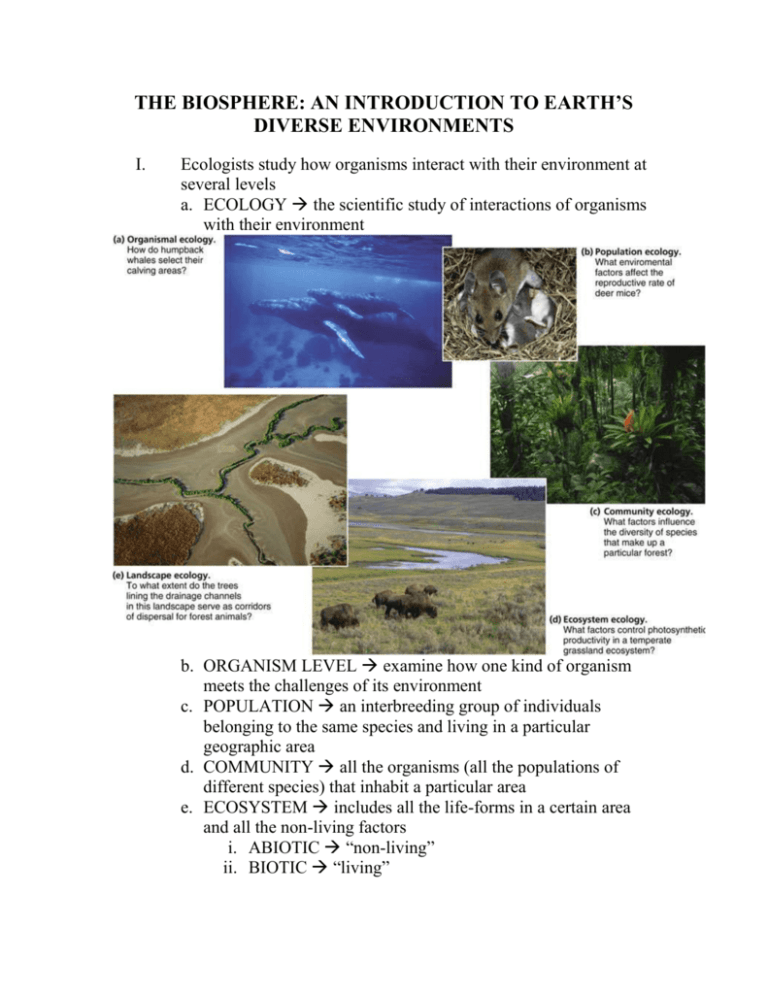
THE BIOSPHERE: AN INTRODUCTION TO EARTH’S DIVERSE ENVIRONMENTS I. Ecologists study how organisms interact with their environment at several levels a. ECOLOGY the scientific study of interactions of organisms with their environment b. ORGANISM LEVEL examine how one kind of organism meets the challenges of its environment c. POPULATION an interbreeding group of individuals belonging to the same species and living in a particular geographic area d. COMMUNITY all the organisms (all the populations of different species) that inhabit a particular area e. ECOSYSTEM includes all the life-forms in a certain area and all the non-living factors i. ABIOTIC “non-living” ii. BIOTIC “living” II. The biosphere is the total of all of Earth’s ecosystems a. BIOSPHERE the global ecosystem; the sum of all the planet’s ecosystems b. HABITATS environmental areas in which communities live III. Environmental problems reveal the limits of the biosphere a. Early technological development led to a misuse and mistreatment of the biosphere b. Concerns exist about human-kinds effect on the environment IV. Physical and chemical factors influence life in the biosphere a. Some of the more important abiotic factors are i. SOLAR ENERGY ii. WATER iii. TEMPERATURE iv. WIND b. There are more factors like natural disasters, pH, soil structure and mineral composition V. Organisms are adapted to abiotic and biotic factors by natural selection a. The presence of a species in a particular place may come about in two ways i. It evolved in that location ii. It disperses to that location and is able to survive VI. Regional climate influences the distribution of biological communities a. TROPICS latitudes between 23.5 N and 23.5 S b. DOLDRUMS an area of calm or of very light wind near the equator c. TRADE WINDS air moving back to the equator from 30 latitude d. TEMPERATE ZONES latitudes between the tropics and the Arctic and Antarctic circle e. PREVAILING WINDS major global air movement i. Results from the rising and falling air masses and Earth’s rotation f. WESTERLIES wind blowing from west to east g. OCEAN CURRENTS river-like flow patterns in the ocean h. BIOMES major type of ecosystem VII. Oceans occupy most of Earth’s surface a. About 75% of planet’s surface is covered by water b. ESTUARY area where freshwater stream merges with ocean c. WETLAND an ecosystem that is an intermediate between an aquatic ecosystem and a terrestrial one d. INTERTIDAL ZONE the wetland at the edge of an estuary, or ocean, where water meets land e. f. g. h. i. j. k. l. PELAGIC ZONE open ocean PHYTOPLANKTON “plant-like” drifters ZOOPLANKTON “animal-like” drifters BENTHIC ZONE sea-floor PHOTIC ZONE area to which light penetrates the ocean APHOTIC ZONE no light CONTINENTAL SHELF submerged part of the continent CORAL REEFS diverse underwater ecosystem VIII. Freshwater biomes include lakes, ponds, rivers, streams, and wetlands a. Nitrogen and phosphorous are the limiting nutrients in lakes or ponds i. Sewage plants greatly increase these nutrients; but it can be dangerous for the ecosystem IX. Terrestrial biomes reflect regional variations in climate a. Nine major types of biomes b. Usually named for climatic features c. Distribution of biomes largely depends on climate X. Tropical forests cluster near the equator a. TROPICAL FORESTS occur in equatorial areas where the temperature is warm and the days are 11-12 hours long year round XI. Ecologist Ariel Lugo studies tropical forests in Puerto Rico a. Ecosystems recover much faster from natural disasters than from human effects XII. Savannas are grasslands with scattered trees a. SAVANNA a biome dominated by grasses and scattered trees XIII. Deserts are defined by their dryness a. DESERTS the driest of all terrestrial biomes, characterized by low and unpredictable rainfall i. DESERTIFICATION the conversion of a semi-arid region to desert XIV. Spiny shrubs dominate the chaparral a. CHAPARRAL a region of dense, spiny shrubs with tough evergreen leaves XV. Temperate grasslands include the North American prairie a. TEMPERATE GRASSLAND have some of the characteristics of tropical savannas, but they are mostly treeless, except along rivers, or streams, and are found in regions of relatively cold winter temperatures XVI. Deciduous trees dominate temperate forests a. TEMPERATURE DECIDUOUS FORESTS grow throughout mid-latitude regions, where there is sufficient moisture to support the growth of large trees XVII. Coniferous forests are often dominated by a few species of trees a. CONIFEROUS FORESTS (a.k.a. TAIGA) cone bearing evergreen trees such as spruce, pine, fur, and hemlock dominate this biome i. Characterized by long, cold winters, and short, wet summers that are sometimes warm XVIII. Long, bitter cold winters characterize the tundra a. TUNDRA areas covered permanently with ice and snow i. PERMAFROST continuously frozen subsoil
